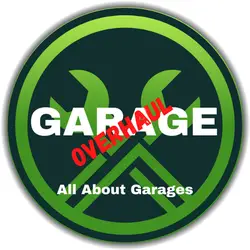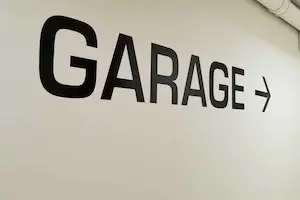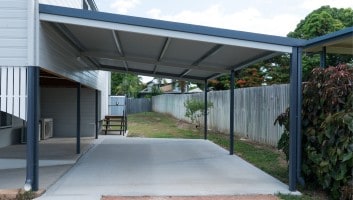Types of Paint for Garage Doors
This post contains affiliate links.
If your garage door is faded to the point of being an eyesore, it’s time to get some paint! There are many products at the hardware store to choose from, which can get confusing. If you’re like me and just want to just start painting, I’ll go over what you need to grab at the store and tell you about some crucial preparation you need to do for your project to make the paint last the longest.
Paint your garage door exterior paint. For best results, use microporous latex paint or wood stain on wood, oil-based paint on bare metal, or doors that have oil paint on previously. Latex on anything painted with latex before, and fiberglass is good with oil or latex.
For your upcoming painting task, knowing the material of your garage door ensures that you choose the paint with better adhesion properties to make it last longer. But that’s not all. Pre-painting preparations are just as critical as the paint itself. Discover why cleaning and surface preparation should be given the proper attention before the paint touches your garage door.
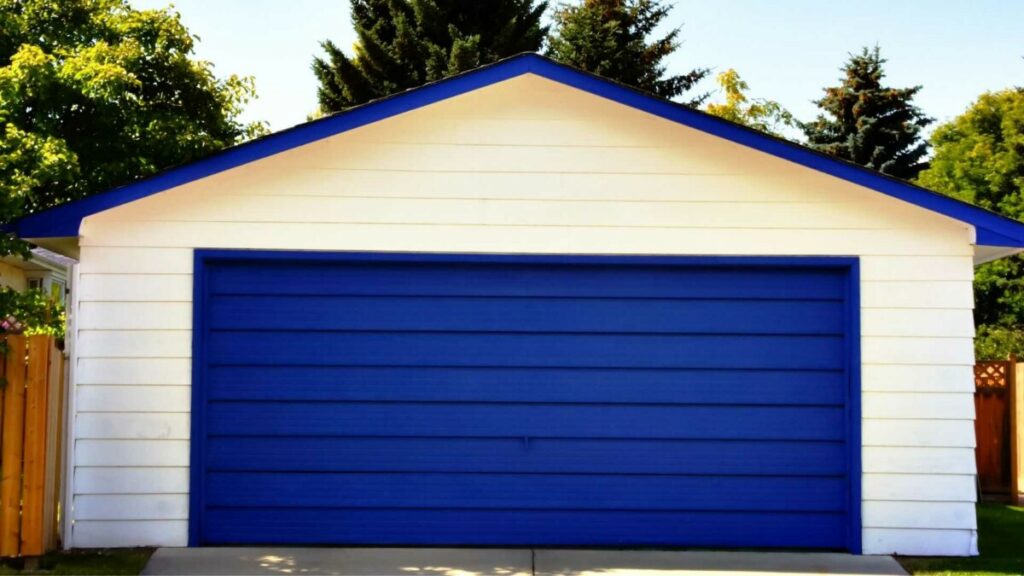
Choosing the Best Paint to Use in Your Garage Door
There are several different materials used for garage doors. Some paints are best suited for one type than the other. Determining your garage door material will help you use the paint that will last longer on your garage door. Common materials used as garage doors are metals – steel or aluminum, wood, and composites – vinyl or fiberglass.
Exterior paints and exterior primers are used in painting garage doors. Exterior paints have two types: latex or oil-based. Latex is the common term to refer to water-based paints. Oil-based paints are from natural oils or alkyd paints that use synthetic oil.
Interior paints are not mixed with bonding ingredients that work well with the outside environment. Using interior paint tends to form a film between the surface of the door and the paint. Thus, the paint peels off easily when exposed to different weather conditions.
All door types adhere well to exterior latex paint, but wood has better adhesion properties than oil-based paint. For reasons we’ll get to it in a moment.
What Paint to Use: Latex vs. Oil-Based
Metal Doors
Oil-based paint best protects from rust when painting a new metal garage door or a bare door. Suppose you are painting an existing metal garage door that has latex paint on it already. In that case, you’ll need to continue to use latex. If you wanted to switch oil-based, you’d need to sand off the old latex down to the bare metal first.
For the type of finish that looks best on metal doors, gloss or semi-gloss paints are recommended. This help protects the metal from scratches and holds up very well in humidity. Exterior gloss paints are low maintenance, too. Just wipe from time to time to remove dirt buildup.
Metals need to be adequately primed to protect them from rust. Best to choose primers that have anti-rust properties for your metal garage door.
Here is a quick guide to choosing the paint for your metal garage door.
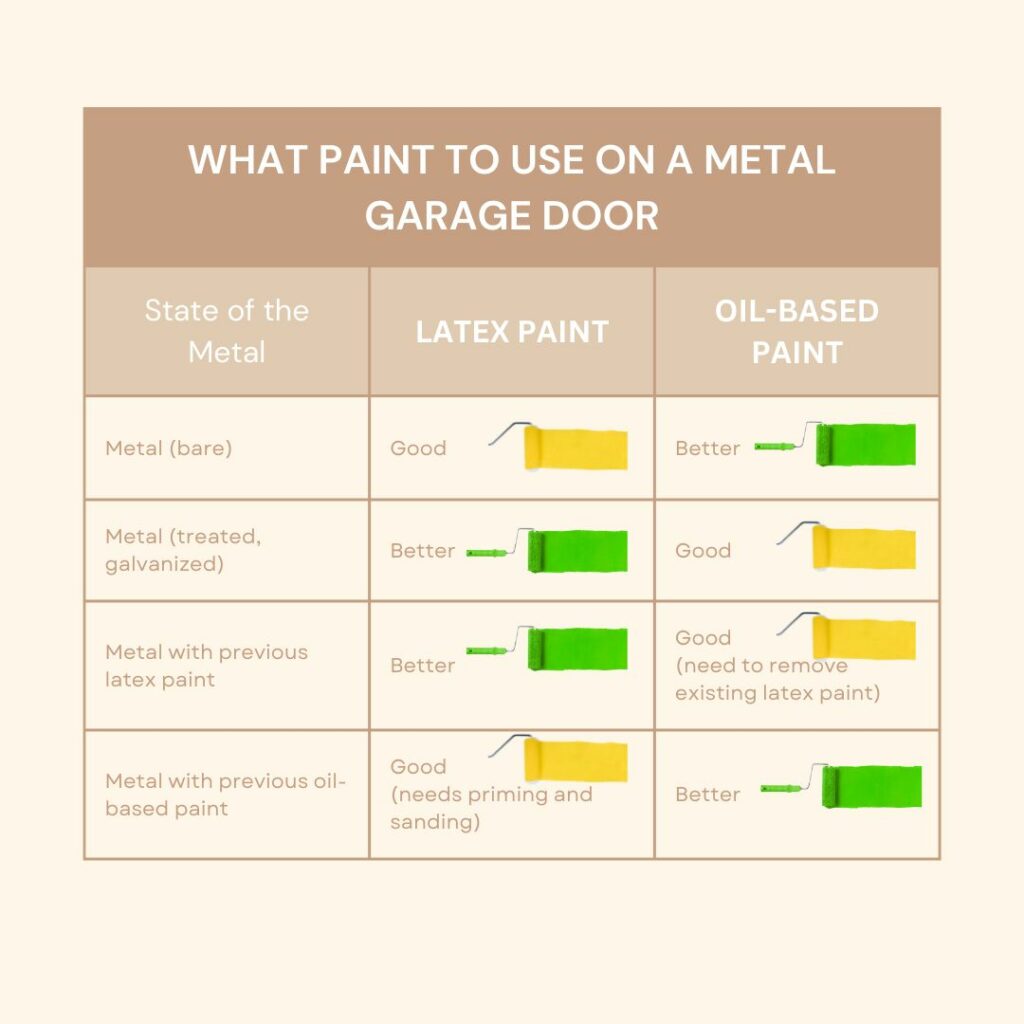
| State of the Metal | Latex | Oil-Based |
| Metal (bare) | Good | Better |
| Metal (treated, galvanized) | Better | Good |
| Metal with previous latex paint | Better | Good (need to remove existing latex paint) |
| Metal with previous oil-based paint | Good (needs priming and sanding) | Better |
Wooden Doors
You’re likely to be recommended by the store to use oil-based paints for your wooden garage door. Oil-based paints are the most commonly used type for wood. However, this may not be the best choice long term.
Wood tends to absorb moisture from the surroundings. And as science tells us, oil and water do not fix. The film will form between the space where the paint was absorbed into the wood and moisture creeps in. This is why old wood sheds and barns get “paint chips.”It is also typical to see a wooden garage door with mold on one or both sides, but the core is super dry.
The key should be to prevent moisture from entering the wood. Latex paint that is microporous or moisture permeable is gaining attention now. Microporous means the paint allows the wood to breathe while preventing moisture from permeating the wood. This improvement came to latex paints around 2018 or so.
Wood by itself is aesthetically satisfying. So when using bare wood, no priming is needed. You can choose between two wood finishing techniques: staining or painting. But keep in mind these techniques work best on bare wood. Staining is applying liquids to treat the wood, which can change its color. This technique highlights the wood’s natural properties.
Stains are designed to protect the wood, but people tend to use them to change the color of the wood to their liking. Staining, unlike painting, amplifies the wood’s natural beauty, as it does not cover the exterior of the wood. Stains are so pigmented that they can easily change the color of the wood. Stains can either be translucent or have different colors.
After staining the wood, you’ll have to apply several coats of wood finish on top of the stain to make your door weatherproof. Painting a wood door instead of staining it will also protect it from weather and is better if you need to cover your wood door’s imperfections if it is not a brand-new door.
Refer to the table below for your quick reference in painting a wooden garage door.
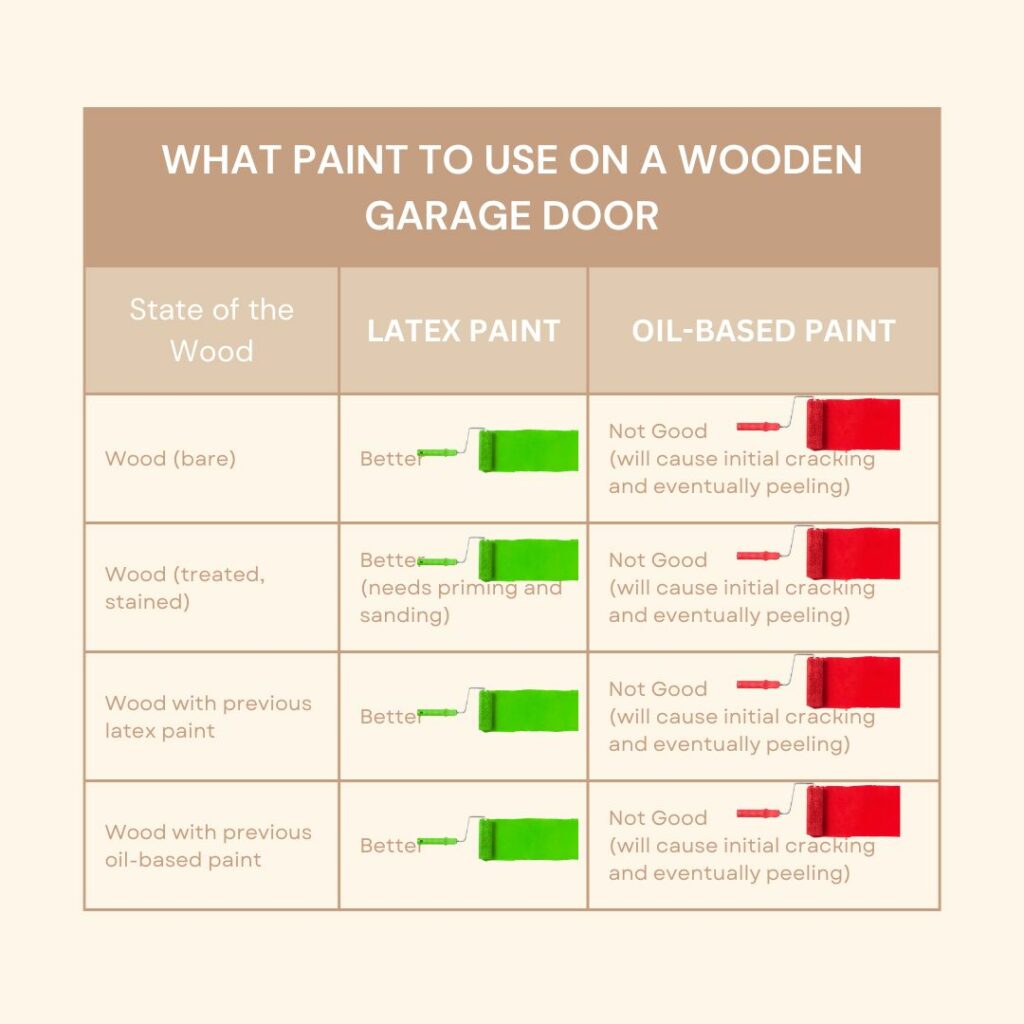
| State of the Wood | Latex | Oil-Based |
| Wood (bare) | Better | Not Good (will cause initial cracking and eventually peeling) |
| Wood (treated, stained) | Better (needs priming and sanding) | Not Good (will cause initial cracking and eventually peeling) |
| Wood with previous latex paint | Better | Not Good (will cause initial cracking and eventually peeling) |
| Wood with previous oil-based paint | Better | Not Good (will cause initial cracking and eventually peeling) |
Vinyl or Fiberglass Doors
Composites like vinyl and fiberglass are coined as kid-friendly as both do not rust easily. They are made from materials less subject to denting or cracking. Both can handle constant abuse from throwing toys, or anything kids can get their hands off.
Vinyl is scratch-proof as it is made from a type of plastic made from chlorine and ethylene. Fiberglass is scratch-resistant and made from thin glass fibers woven together.
Composites can either go with water-based or oil-based exterior paints. Their composition adheres to both exterior paint almost at the same level.
Painting Your Garage Door: The Dos And Don’ts
Do Not Forego the Basics
These four steps apply regardless of the garage door material. The steps are basically the same across the material type. They may differ only on particular circumstances, which I will cover.
Cleaning
No paint will adhere to a dirty surface. Cleaning is vital in ensuring the paint will adhere better to the garage door, making it last longer. Remove any visible bumps and dirt buildup on the garage door’s surface. Before sure, the door is dry before painting.
Read here how to properly clean the garage from top to bottom.
Metal
Most bare metal garage doors are already subjected to treatment while in production. If using bare or new metal, you can just hose down the surface to remove first accumulated while in storage.
In using galvanized steel, it is recommended to clean it with white vinegar or ammonia. The chemicals in both substances reacting to the zinc will pave the way to better paint adhesion. Keep in mind to be in a well-ventilated area if you plan to use ammonia.
Wood
While cleaning, inspect the wooden door for any traces of paint peeling, mildew buildup, and mold. Use warm soapy water to thoroughly clean the wooden surface. Leave it for at least 24 hours to ensure it is dry. Remember that wood absorbs moisture, so keeping it dry is essential.
Preparation: Sanding and Priming
This step is crucial if you put paint over a surface with the existing paint. It means to roughen the surface to promote better adhesion. This is also called profiling the surface.
Water-based primers to water-based paint and oil-based primers to oil-based paint. Putting primers before painting provides a necessary layer of protection and treatment to the surface to help the adhesion of paint last longer.
The general rule is to use a primer with the same base as your paint. This rule is broken in cases applicable to wooden garage doors, where you would want to transition from an existing oil-based paint to latex paint.
A good primer recommendation is those with treatment properties for rust, mold, mildew, or anything you want to protect your garage door from, mixed into the primer formula. My favorite brand is currently “Kills All” There are isles of it in your typical Home Depot.
Metal
For industrial work, you can sandblast the steel’s surface. However, you can use wash primer or grind/sand the surface for backyard work. Wash primers can be applied using a spray, roller, or brush. The key is to ensure the surface is adequately dried.
Grinding or sanding provides a rough surface quickly via a grinder or sanding tools. A tip for metal garage doors is the force should be controlled to give a rough surface but not totally remove the zinc coating.
Wood
If you are repainting an old garage door, sanding is essential to the painting process. Old paint will be removed, giving you a wooden surface that is almost bare to keep the primer and paint better adhesion. Dry for 24 hours at the minimum for the primer to thoroughly coat the wood.
Use the general rule to use the same base primer to paint, except when you intentionally transition from one exterior paint type to another. Avoid oil-based primers to ensure latex paint will have a better chance of lasting longer.
Painting the Garage Door
After all the preparations, you can now paint your garage door. Seems that this step is actually the easiest across all the preparations.
Making the paint adhere appropriately to the garage door surface is a critical component of painting. The criticality combines getting the correct exterior paint type, prepping your surface, and investing in quality materials. And painting basics working together to make your painting task a success.
A few things to remember is that humidity can add to the moisture buildup on the surface. Streaks can form on the surface if it gets wet while painting. Prepping your surroundings to minimize rain exposure and preventing your surface from getting wet. Paint tends to dry longer in cold weather. Best to paint mid-morning to mid-afternoon to lessen humidity.
The surface of your garage door needs to be adequately dried. Keep the surface dry before painting, during painting, and after painting. The first layer of paint should be thoroughly dried before the second layer is added.
Partner your paints and primers so that their ingredients complement each other in protecting your paint. Some treatments include UV resistance, microporous element, and insulating treatment.
Metal
Spray paints are easier to use for metals. It can go into the crevices and bumps of the metal. If painting in cold weather, check from time to time if the surface is wet before spraying an area.
Wood
Rollers or brushes can provide the most effective paint adhesion compared to sprays. Regardless of the finish, you choose for your wooden garage door, painting, or staining, remember that wooden garage doors have upkeep.
Wooden garage doors need to be refinished in two to three years. There is no standard rule, but it needs to be monitored for any signs of mold, mildew, or rotting. And lastly, remember that the existing finish needs to be scraped off entirely before refinishing.
Vinyl and Fiberglass
There is no particular step for vinyl and fiberglass, as one of the good things about composites is low maintenance. Vinyl has one color. Thus visible scratches are hidden from plain sight. The paint applied in vinyl does not fade. Upkeep can depend on the owner’s preference. Fiberglass needs a clear top coat reapplied for a minimum of one year, up to three years.
Post Painting Considerations
Here are a few items to consider pre, during, and post your painting task.
Schedule a routine inspection of your garage doors.
Look for rust for steel and metal, mold for wood, and cracking for vinyl or fiberglass surfaces. Early detection and treatment can save you from changing the whole garage door. Refinish either with repainting or restaining every one to three years. Or depending on the state of the garage door.
Where you are in the world matters.
So if you can, you should consider the climate in your area before choosing the material for your garage door. Fiberglass and vinyl are best in humid areas with warmer climates. Not recommended for windy areas as both materials can evoke a noise when windy.
Wood can absorb water, causing it to expand and rot. For areas with high humidity, wooden garage doors might not be the best idea. The upkeep cost and time might not be worth the aesthetic pleasure.
Any metal material for garage doors is suitable for any weather. Just keep in mind the routine inspection to keep out rust.
Overall House Design and Theme
White is the go-to paint color for garage doors. This color goes well with whatever color of the house is. Another good thing about having white as your garage door color is that it does not necessarily need to be changed. When you decide to change the house’s color.
Pick a color that contrasts with the house’s overall color. This is to provide a sort of separation between the main house and the garage. Keeping the color in contrast with the house color, but keeping it cohesive with the rest of the house, gives continuity to the design and theme.
How Much Does It Cost to Paint a Garage Door?
If you want the job done by professionals, Here is up-to-date info at Homeguide.com
https://homeguide.com/costs/cost-to-paint-garage-door
Conclusion
The key to making paint on your garage doors last the longest is strengthening the adhesion qualities of your materials – the paint and your garage door. Knowing the material of your garage door and the best exterior paint that offers the best bonding will make a difference.
Wood, metal – steel or aluminum, and composites – vinyl or fiberglass work best with exterior latex paints. Oil-based paints are commonly recommended for wood garage doors – though this may not be the best choice in the long run.
Painting is a multi-step process and should not be hastily done. Don’t forget that even before the paint touches your garage door, cleaning and prepping the surface is crucial in keeping the paint bonded and lasting longer.
Read also all about how to paint your garage floor in this article.
Reference(s):
- https://www.bobvila.com/articles/2449-garage-doors-101/
- https://diypaintingtips.com/best-garage-door-paint/
- https://www.paintritepros.com/blog/how-to-paint-a-metal-garage-door/
- https://m.youtube.com/watch?v=J41JNBxPAJ8
- https://m.youtube.com/watch?v=XsVZen9ILew
- https://www.yourcarcave.com/paint-to-use-for-a-garage-door/
- https://www.qualitydoorcompany.com/blog/guide-to-choosing-the-best-garage-door-material/
- https://www.4feldco.com/articles/types-of-garage-doors/
- https://monnigindustry.com/2020/10/02/4-steps-to-paint-galvanized-steel/
- https://www.paintritepros.com/blog/how-to-paint-a-metal-garage-door/#:~:text=Acrylic%20latex%20exterior%20house%20paint,need%20to%20apply%20several%20coats.
- https://painttopics.com/how-to-paint-galvanized-metal/
- https://home.howstuffworks.com/home-improvement/home-diy/painting/how-to-paint-galvanized-metal.htm
- https://indmetalstrap.com/paint-galvanized-steel-4-easy-steps/
- https://painttopics.com/how-to-paint-galvanized-metal/
- https://www.rawlinspaints.com/blog/how-to-paint-galvanised-metal/
- https://galvanizeit.org/specification-and-inspection/specifying-duplex-systems/preparing-hdg-for-paint
- https://chameleon-decorators.co.uk/blog/paint-metal-garage-door/
- https://www.nygates.com/how-do-i-paint-wood-garage-doors/
- https://www.diydoctor.org.uk/projects/paintingwoodengaragedoor.htm
- https://www.overheaddoors.com/blog/how-to-paint-a-wooden-garage-door/
- https://chameleon-decorators.co.uk/blog/wooden-garage-door/
- https://paintersworld.co.uk/painters-advice/paint-for-garage-doors
- https://www.creativedoor.com/blog/help-me-choose-vinyl-vs-fibreglass-garage-doors
- https://www.directserviceoverhead.com/fiberglass-vs-vinyl-garage-doors/
- https://www.overheaddoorco.com/blog/whats-the-best-material-for-a-garage-door
- https://www.overheaddoorco.com/blog/should-i-paint-my-garage-door
- https://selectdoorservice.com/2022/05/09/can-you-paint-a-vinyl-garage-door/
- https://homeguides.sfgate.com/dyson-v8-worth-cost-13772127.html
- https://www.chiohd.com/blog/choosing-the-best-garage-door-material
